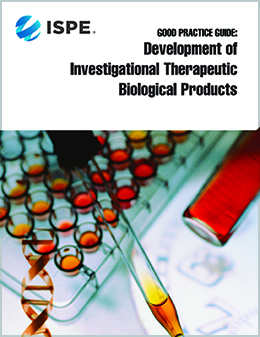Good Practice Guide: Development of Investigational Therapeutic Biological Products

Published: August 2007
Pages: 92
With the rapid growth in the biopharmaceutical industry over the past two decades, the number of newly approved biological products has dramatically increased. In 2005, a record 21 biological products received US Food and Drug Administration (FDA) approvals, including therapies for the treatment of rheumatoid arthritis, diabetes, cancer, and rare genetic disorders.
With the increasing number of approved biological products on the global market come major challenges for many biopharmaceutical companies, especially during the critical process development and manufacturing stages of product development.
This Guide will consider the major issues that will confront a biopharmaceutical company in moving therapeutic biological products from the laboratory to the clinic and beyond. The Guide is intended to provide readers with an understanding of issues surrounding product and process development, manufacturing, investigational product supply chain management, quality control/quality assurance, and global regulatory requirements for biopharmaceuticals.
The intended audience for this Guide includes the following disciplines:
- Clinical Supply/Clinical Trial Materials
- Clinical Research
- Manufacturing
- Project Management
- Quality Assurance/Quality Control
- Regulatory Affairs
- Research and Development
The Guide specifically addresses the methods and challenges surrounding recombinant therapeutic biological product development, including considerations during its use in clinical trials.
It focuses on project planning/management, preclinical/clinical phases, comparability and bridging studies, Active Pharmaceutical Ingredient (API)/Drug Substance (DS)/Drug Product (DP)/placebo process development, manufacturing of DS/DP, process validation, supply chain management of biological investigational products for clinical trials, quality control/quality assurance considerations, and global regulatory strategies.
The regulations and guidelines from the US, EU, Canada, Japan, and ICH have been considered in the development of this Guide. While not in the scope of this Guide, it is recognized that the development of other biologics (e.g., cellular and gene therapy) may require additional considerations for their successful product development from the laboratory to the clinic.
Emerging Economy Publication Discount
ISPE members located in nations with emerging economies* are eligible for a 50% discount on publications from the regular member price. To receive the discount, members must be logged in with their ISPE member account. Contact Member Services at ask@ispe.org for more information or if you have questions about your membership status or this discount program. Discounts do not apply to Techstreet document downloads.
*Based on the World Bank's system for classifying national economies by GNI per capita. Includes low-income, lower middle-income, and upper middle-income economies. To learn more about the World Bank classification system, please click here. Currently includes the following nations, except where international sanctions apply:
- Afghanistan
- Albania
- Algeria
- Angola
- Argentina
- Armenia
- Azerbaijan
- Bangladesh
- Belarus
- Belize
- Benin
- Bhutan
- Bolivia
- Bosnia and Herzegovina
- Botswana
- Brazil
- Bulgaria
- Burkina Faso
- Burundi
- Cabo Verde
- Cambodia
- Cameroon
- Central African Republic
- Chad
- China
- Colombia
- Comoros
- Congo, Dem. Rep.
- Congo, Rep.
- Costa Rica
- Côte d’Ivoire
- Cuba
- Djibouti
- Dominica
- Dominican Republic
- Ecuador
- Egypt, Arab Rep.
- El Salvador
- Equatorial Guinea
- Eritrea
- Eswatini
- Ethiopia
- Fiji
- Gabon
- Gambia, The
- Georgia
- Ghana
- Grenada
- Guatemala
- Guinea
- Guinea-Bissau
- Haiti
- Honduras
- India
- Indonesia
- Iran, Islamic Rep.
- Iraq
- Jamaica
- Jordan
- Kazakhstan
- Kenya
- Kiribati
- Korea, Dem. People's Rep.
- Kosovo
- Kyrgyz Republic
- Lao PDR
- Lebanon
- Lesotho
- Liberia
- Libya
- Madagascar
- Malawi
- Malaysia
- Maldives
- Mali
- Marshall Islands
- Mauritania
- Mauritius
- Mexico
- Micronesia, Fed. Sts.
- Moldova
- Mongolia
- Montenegro
- Morocco
- Mozambique
- Myanmar
- Namibia
- Nepal
- Nicaragua
- Niger
- Nigeria
- North Macedonia
- Pakistan
- Palau
- Papua New Guinea
- Paraguay
- Peru
- Philippines
- Russian Federation
- Rwanda
- Samoa
- São Tomé and Príncipe
- Senegal
- Serbia
- Sierra Leone
- Solomon Islands
- Somalia
- South Africa
- South Sudan
- Sri Lanka
- St. Lucia
- St. Vincent and the Grenadines
- Sudan
- Suriname
- Syrian Arab Republic
- Tajikistan
- Tanzania
- Thailand
- Timor-Leste
- Togo
- Tonga
- Tunisia
- Türkiye
- Turkmenistan
- Tuvalu
- Uganda
- Ukraine
- Uzbekistan
- Vanuatu
- Vietnam
- West Bank and Gaza
- Yemen, Rep.
- Zambia
- Zimbabwe